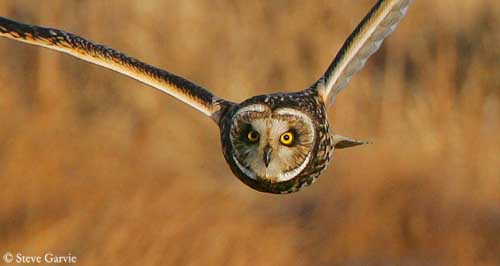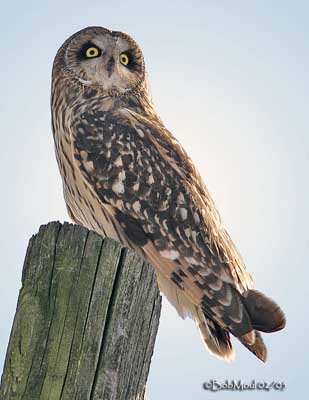
Short-eared Owl
Asio flammeus
Strigiforme Order – Strigidae Family
BIOMETRICS:
Length: M : 37 cm – F : 38 cm
Wingspan: M : 105 cm - F : 107 cm
Weight: M : 200-450 g – F : 280-500 g
DESCRIPTION:
Short-eared Owl is a nocturnal owl, sometimes diurnal in breeding season, but only about one hour before sunset. It is medium-sized, but when perched, the bird is more eagle-like than owl because it is bulky.
PROTECTION / MENACES / STATUS:
The young birds are threatened by diurnal raptors, eagles, falcons and Snowy Owls. Nests are destroyed by mammals such as dogs, foxes and coyotes. Corvidae and Laridae take eggs and chicks at nest.
The Short-eared Owl is killed by collisions with vehicles, and also planes on airports where they often occur in open areas.
Habitat loss for agriculture and grazing, poisoning, human disturbances and developments are important threats, but on the other hand, the species has benefited from the protection of nesting cover for waterfowls and at this moment, Short-eared Owl is not threatened.
Fr: Hibou des marais
All : Sumpfohreule
Esp: Búho Campestre
Ital: Gufo di palude
Nd: Velduil
Russe: Болотная сова
Sd: Jorduggla
Photographers:
Steve Garvie
RAINBIRDER Photo galleries
Bob Moul
Nature Photography
Text by Nicole Bouglouan
Sources:
HANDBOOK OF THE BIRDS OF THE WORLD Vol 5 by Josep del Hoyo-Andrew Elliott-Jordi Sargatal - Lynx Edicions - ISBN: 8487334253
THE HANDBOOK OF BIRD IDENTIFICATION FOR EUROPE AND THE WESTERN PALEARCTIC by Mark Beaman, Steve Madge - C.Helm - ISBN: 0713639601
THE COMPLETE BOOK OF BRITISH BIRDS – Written by “Royal Society for the Protection of Birds” experts - Préface de Magnus Magnusson - Michael Cady- Rob Hume Editors - ISBN: 0749509112
What Bird-The ultimate Bird Guide (Mitchell Waite)
Wikipedia (Wikipedia, The Free Encyclopedia)

The upperparts are mottled brown and buff. The long and broad wings show a pale ochre patch on the underside. The central rectrices are buff and blotched brown between several dark bars, about 5-6.
The underparts are whitish to pale buff, heavily streaked dark brown, but more finely on sides and flanks. Underwing is buffy-white with black tips and dark wrist patch.
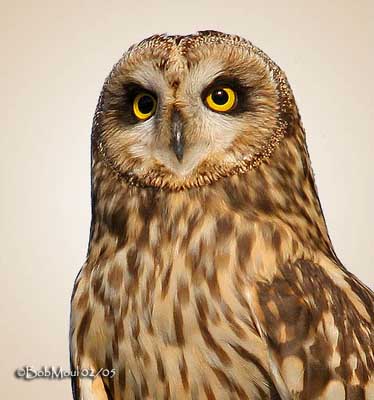
Female is slightly larger than male. She is browner above, and buffer below, and more heavily streaked.
Juvenile has darker crown and rump, brown-black facial disc with tipped-buff feathers and buff underparts.
We find several subspecies sharing the wide range. They differ in coloration, more or less dark or pale, with more grey or brown according to the race.
VOICE: SOUNDS BY XENO-CANTO
The Short-eared Owl is usually silent. Its territorial call, given in flight and during breeding season is a series of about 15 notes “voo-hoo-hoo-hoo-hoo-hoo…”.
Female utters some barks “kee-ow” as response.
When excited at nest, they give raucous calls, barks, yapping and whistles.
The head is large and rounded. Ear tufts are very short and usually unseen. The facial disc is greyish-white, but eyes are surrounded with black. Chin and forehead are white.
Bill is black. Eyes are yellow. Legs and feet are feathered whitish-buff.
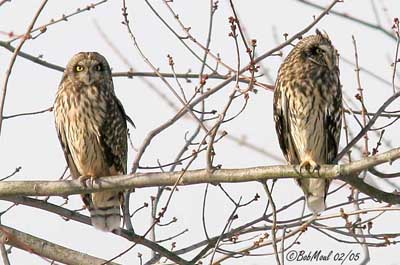
HABITAT:
The Short-eared Owl frequents open countries such as tundra, savannahs, grasslands, marshes, moorland and montane forest.
They need habitat associated with small mammal’s populations, especially in North America. Sufficient ground cover is necessary as shelter for the nest.
This species may be seen from sea-level up to 4000 metres of elevation in the Andes.
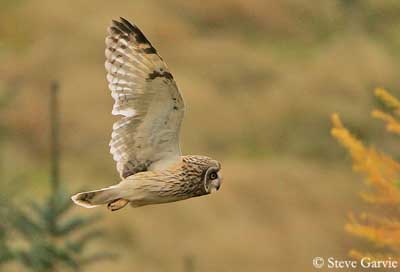
RANGE:
The Short-eared Owl is found in Iceland, Hawaii, Galapagos, North and South America, and also in the Old World.
BEHAVIOUR:
The Short-eared Owl is migratory in the northern parts of the range. During the migrations, its sturdy constitution allows it to cross the high mountain passes.
It feeds mainly by night, in the early morning or just before sunset. It flies at low height over open areas, and swoops down onto the prey as soon as it is localized. In dense vegetation, it flutters above the prey before to dive and to catch it. Occasionally, it may hunt from a perch. The prey is carried in the talons.
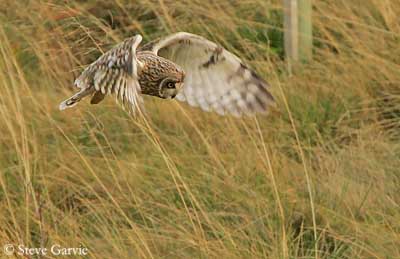
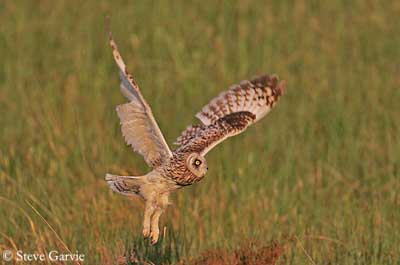
It also harasses eagles, herons and falcons during the diurnal flights, only for pleasure! But the Northern (Hen) Harriers tend to steal them the preys while hunting in the same territory.
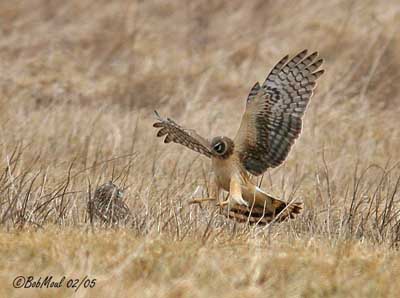
The sedentary owls have large territories of about six hectares, with expansion during the breeding season.
The pair-bonding starts at the end of the winter, involving courtship displays by the male. It rises quickly with exaggerated wing-beats and performs hovering, glides, descents and rises again. We can hear the wing claps while the male utters some notes.

Two owls often engage in flight and grasp their talons while flying or fight briefly. In some displays, fight or courtship, the male may expose the patch of the underwing towards the opponent or the female.
FLIGHT:
The Short-eared Owl flies easily and steadily with regular wing-beats and flapping, or soaring briefly with well open V-shaped wings. It hunts on the wing by fluttering. Its flight is often compared to that of moths.
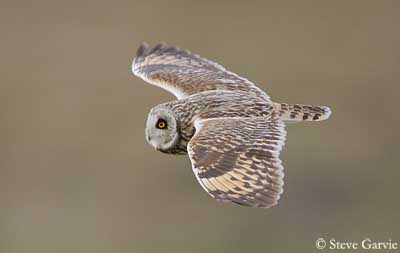
REPRODUCTION:
Breeding season occurs between March and June in N hemisphere, and starts in September in South.
The Short-eared Owl’s nest is a scrape on the ground, in dry place. Female builds it. The interior is lined with bits of grass and feathers of her own breast. It may be sheltered by vegetation such as heather or in open.
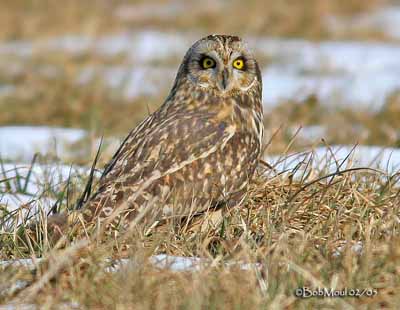
Female lays 4-10 white eggs of about 40 mm in size (average 5-7). The broods may be larger when the food resources are abundant. Eggs are laid at one or two days intervals. Incubation lasts 24 to 29 days and starts with the first egg laid. Female incubates most part of the time and she if fed by the male. This one may occasionally take some turns, and it defends the nest by performing distraction displays and uttering calls.
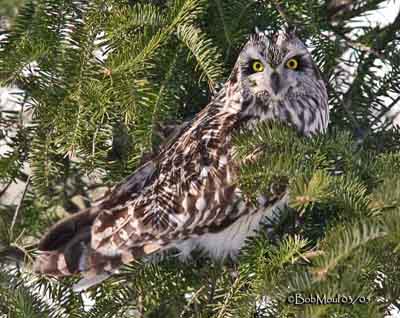
The youngs grow very fast and rummage around the nest at 12 days old. This behaviour makes them less vulnerable to predators by adaptation to the environment. They are feathered at four weeks, and reach their sexual maturity at one year.
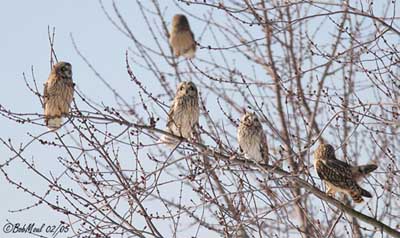
The Short-eared Owl feeds mainly on small mammals, but it also catches birds. Voles are the favourite preys, but mice, squirrels, rats, bats, shrews, moles, muskrats and rabbits are also taken and appreciated!
When hunting in wet areas or along coasts, the Short-eared Owl feeds more on waders, terns, young gulls and other seabirds.
Inland, it feeds on larks, blackbirds and pipits. Some insects may be taken too.
Small mammals are swallowed whole, but it may sometimes clip off the head and eviscerate the prey. Birds are swallowed without the wings.
